
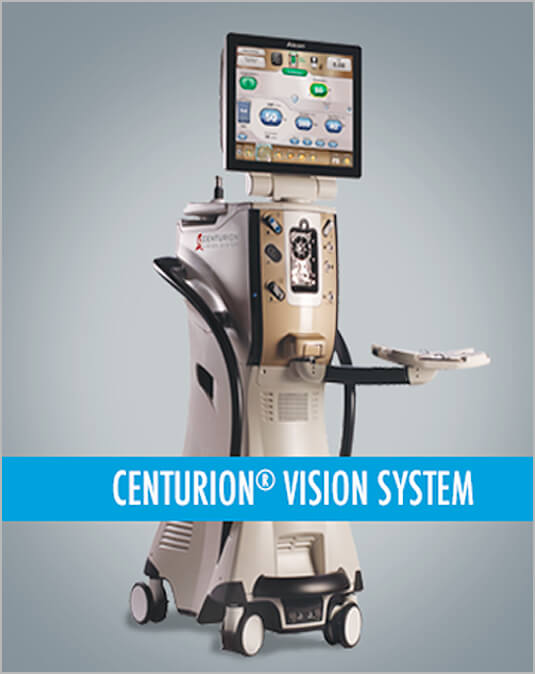
Laservision Eye Care Center is pleased to introduce the newest technology in cataract removal, the Alcon Centurion Vision System. The Centurion System's tri-modal energy delivery options allow our surgeons a greater choice in selecting the surgical method best suited to their patient's needs. Ultrasound phacoemulsification has long been the industry standard, but the Centurion features an improved, lower energy ultrasound handpiece that is lighter and provides greater hand control to the surgeon. This system offers increased flexibility and greater options for the surgeons with more control over the lens-removal procedure, which potentially offers the reduced risk of complications. A major benefit to the patient is the ability to now perform the procedure in less time. Prior to the Centurion, patients with advanced and very dense cataracts expected a more difficult, complicated removal of the lens, but with the Infiniti, that delayed surgical time has been eliminated. The shorter surgery time is much healthier for the eye and potentially causes less swelling to occur to the inside of the eye. Without the potential complications, the patient can expect a quicker recovery of vision. Another plus for both the patient and their accompanying driver is that they can expect to spend less time at the facility. The Alcon Centurion at the Miami Lakes Surgery Center allows our ophthalmic surgeons to continue to offer their patients the very latest advancements in technology.
Our physicians are experts in the latest technique to remove cataracts in patients. This procedure is called "Clear Cornea Cataract Surgery". The operation is done with anesthesia eyedrops--there are no injections to the eye--and the patient usually goes home with no stitches or patch. They teach this procedure twice a week to other doctors.
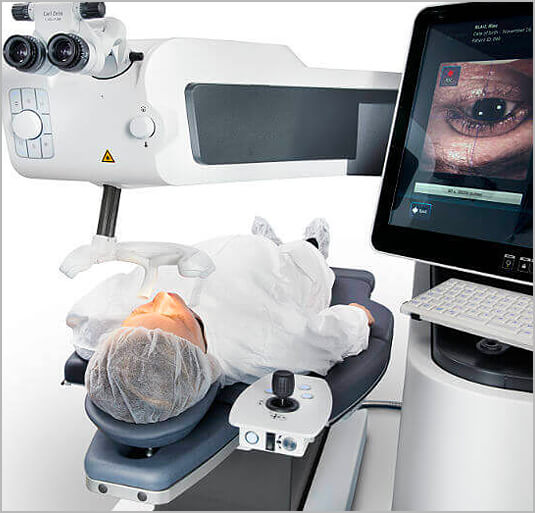
Laservision Eye Care Center offers a number of procedures, including LASEK. Our doctors have been on the leading edge of vision surgery and in fact have had experience with the excimer laser for over 32 years. Research done by the doctors helped get FDA approval for the procedure over 22 years ago. Drs. Trentacoste and Zambrano are experienced in a wide range of procedures and can help select the one that is proper for your particular vision problem.
The LASEK and PRK procedures are done at the Bascom Palmer Eye Institute which has been rated the number one eye facility in the entire United States. Both Dr. Zambrano and Trentacoste are professors at the University of Miami and have taught the resident physicians how to do eye operations. They have been on staff there since 1985. The Visx Star Excimer laser is state of the art and constantly updated with the latest software updates to maximize surgical outcomes and give the best possible clearest vision.
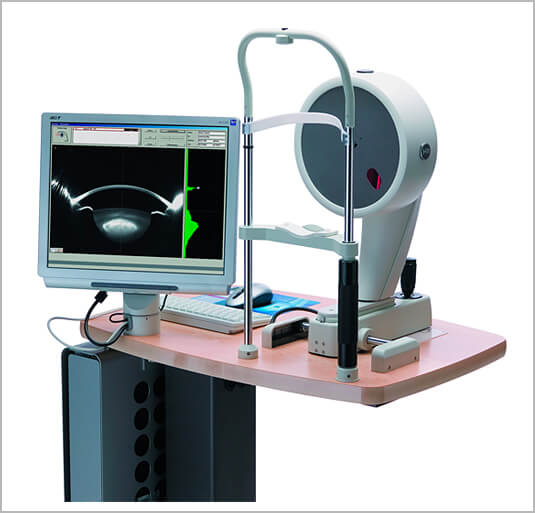
Understanding the shape and thickness of the cornea is important to any refractive procedure. The Pentacam is a diagnostic test that analyzes and measures the cornea, the clear front surface of the eye where light rays enter. When considering laser vision correction or cataract surgery, this advanced diagnostic instrument is a real advantage over all other ocular diagnostic equipment available today.
The Pentacam HR uses a specialized camera which provides sharp, crisp images of the ocular structures from the front (anterior) surface of the cornea to the back (posterior) crystalline lens capsule. In less than 2 seconds, 100 scans of the eye produce an accurate 3-dimensional mathematical model of the front of the eye.
These results provide our doctors precise measurements of the central cornea, illustrations of the individual corneal layers, and imaging of intraocular lens implants in lens replacement surgery. The Pentacam has enabled our doctors to analyze the eye with an accuracy that was previously not available. You can have the confidence that the most accurate clinical data is being collected for your refractive surgery procedure. If you are nearsighted, but not an ideal LASEK candidate, you will be evaluated for another treatment modality Not everyone is an ideal LASEK candidate. If you have a high degree of nearsightedness or a thin cornea, the risk to LASEK may outweigh the benefits of the procedure.
When the crystalline lens increases in density, it causes an excessive scattering of light and blurred vision. This is known as a cataract. Using lens desitometry readings, the Pentacam HR can measure the density of the crystalline lens and objectively measure the amount of its cataractous change. With increasing age, it will be necessary to undergo cataract surgery to maintain functional vision. If you have had previous refractive surgery, such as radial keratotomy (RK) LASEK or LASIK, the Pentacam HR utilizes a special software program to precisely calculate the power of an intraocular lens implant used for cataract surgery. “Equivalent K-readings” determined by the Pentacam HR are implanted into the IOL calculation formulas to accurately determine the correct IOL needed for all patients, even those with abnormal corneas. Instead of using assumptions or approximations, the Holladay Report enables patients who have undergone previous corneal surgery feel assured that their previous eye surgical procedures will not interfere with the outcome of additional necessary surgery.
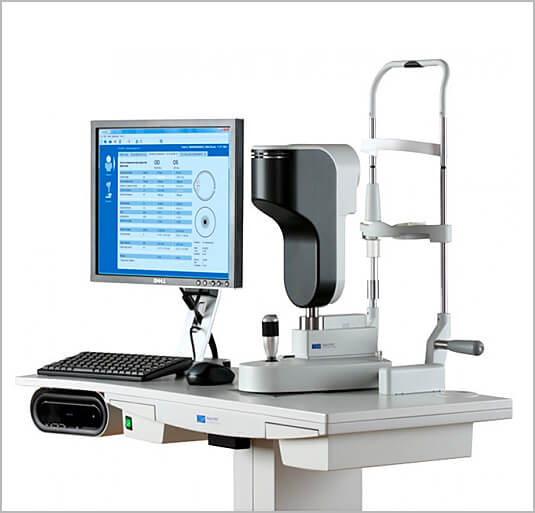
LENSTAR LS900® provides the user with a complete biometrical assessment of the patient’s eye in a single measurement procedure, including lens thickness, anterior chamber depth (lens position) and retinal thickness.
Prior to having an IOL or an ICL implanted in your eye it is necessary to know the precise width of the lens we are going to use. The technology employed by our A-Scan unit provides a visualization of the lens and the surrounding area in high resolution.This in turn allows us to make the proper measurement so that the lens we use fits and thus gives us the result we are looking for.
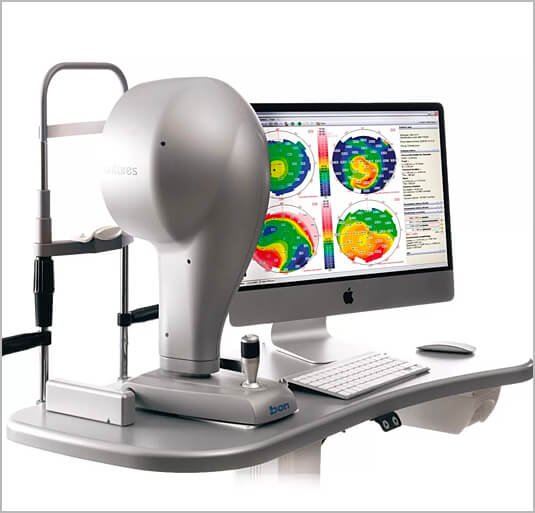
What is OCT?
At Laservision Eye Care Center, we are committed to always placing the patient’s best interest first. That is why we invest in the latest diagnostic technology. Optical Coherence Tomography (OCT) is a relatively new diagnostic modality that provides high-resolution, cross-sectional imaging of the back of the eye. It is capable of detecting changes in the back of the eye that may affect the outcome of your surgery. Thus, we can look for the early stages of diseases like glaucoma, diabetic retinopathy and macula edema, all of which have the potential of changing your sight. The test is as simple as taking a picture. OCT is just a part of our technology investment into your vision improvement.
